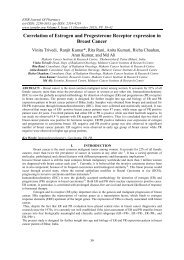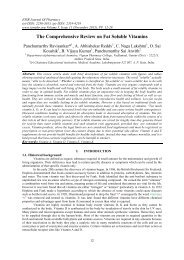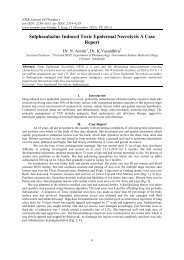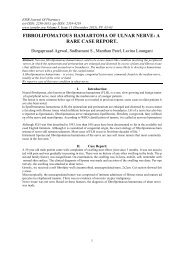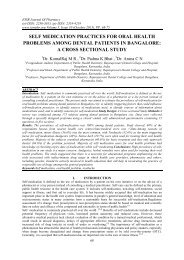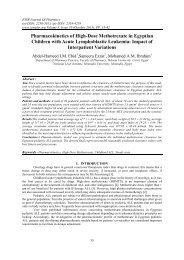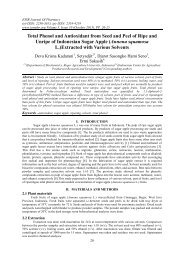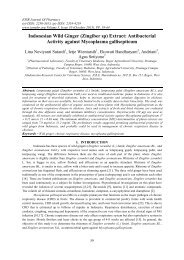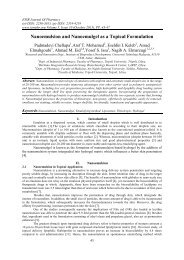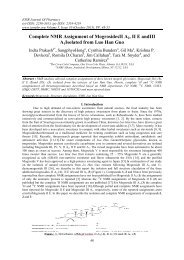“Hemodynamic and recovery profile with Dexmedetomidine and Fentanyl in intracranial supratentorial surgeries: A comparative study”
The IOSR Journal of Pharmacy (IOSRPHR) is an open access online & offline peer reviewed international journal, which publishes innovative research papers, reviews, mini-reviews, short communications and notes dealing with Pharmaceutical Sciences( Pharmaceutical Technology, Pharmaceutics, Biopharmaceutics, Pharmacokinetics, Pharmaceutical/Medicinal Chemistry, Computational Chemistry and Molecular Drug Design, Pharmacognosy & Phytochemistry, Pharmacology, Pharmaceutical Analysis, Pharmacy Practice, Clinical and Hospital Pharmacy, Cell Biology, Genomics and Proteomics, Pharmacogenomics, Bioinformatics and Biotechnology of Pharmaceutical Interest........more details on Aim & Scope).
The IOSR Journal of Pharmacy (IOSRPHR) is an open access online & offline peer reviewed international journal, which publishes innovative research papers, reviews, mini-reviews, short communications and notes dealing with Pharmaceutical Sciences( Pharmaceutical Technology, Pharmaceutics, Biopharmaceutics, Pharmacokinetics, Pharmaceutical/Medicinal Chemistry, Computational Chemistry and Molecular Drug Design, Pharmacognosy & Phytochemistry, Pharmacology, Pharmaceutical Analysis, Pharmacy Practice, Clinical and Hospital Pharmacy, Cell Biology, Genomics and Proteomics, Pharmacogenomics, Bioinformatics and Biotechnology of Pharmaceutical Interest........more details on Aim & Scope).
You also want an ePaper? Increase the reach of your titles
YUMPU automatically turns print PDFs into web optimized ePapers that Google loves.
IOSR Journal Of Pharmacy<br />
(e)-ISSN: 2250-3013, (p)-ISSN: 2319-4219<br />
www.iosrphr.org Volume 5, Issue 11 (November 2015), PP. 43-48<br />
<strong>“Hemodynamic</strong> <strong>and</strong> <strong>recovery</strong> <strong>profile</strong> <strong>with</strong> <strong>Dexmedetomid<strong>in</strong>e</strong> <strong>and</strong><br />
<strong>Fentanyl</strong> <strong>in</strong> <strong>in</strong>tracranial <strong>supratentorial</strong> <strong>surgeries</strong>: A <strong>comparative</strong><br />
<strong>study”</strong><br />
Dr.Manoj Tripathi 1 , Dr.Virendra Kumar 2 , Dr.Deepak Malviya 3 ,<br />
Dr.Mahendra S<strong>in</strong>gh 1 , Dr.Manoj Kumar 4 , Dr.Amit Tyagi 1<br />
1- Senior Resident, Dr.Ram Manohar Lohia Institute Of Medical Sciences, Lucknow, Uttar Pradesh India<br />
2- Assistant Professor, Dr.Ram Manohar Lohia Institute Of Medical Sciences, Lucknow, Uttar Pradesh India<br />
3- Professor, Dr.Ram Manohar Lohia Institute Of Medical Sciences, Lucknow, Uttar Pradesh India<br />
4- Senior Resident, Madan Mohan Malviya Hospital , New Delhi ,India<br />
Abstract: Background: <strong>Dexmedetomid<strong>in</strong>e</strong> (DEX) has shown analgesic effects <strong>with</strong>out significant respiratory<br />
depression. As <strong>Dexmedetomid<strong>in</strong>e</strong> (DEX) provides good perioperative hemodynamic stability <strong>with</strong> decreased<br />
<strong>in</strong>traoperative opioid requirements, <strong>and</strong> neural protection, it might be a suitable anaesthetic adjuvant to<br />
neurosurgical anaesthesia. <strong>Fentanyl</strong> is a synthetic opioid <strong>with</strong> analgesic potency 50-100 times more than that of<br />
morph<strong>in</strong>e <strong>and</strong> can be a valuable component of neuroanesthesia but can cause respiratory depression.<br />
Aims <strong>and</strong> objectives: The aim of this study is to compare hemodynamics <strong>and</strong> <strong>recovery</strong> <strong>profile</strong> <strong>with</strong><br />
dexmedetomid<strong>in</strong>e <strong>and</strong> fentanyl <strong>in</strong> <strong>supratentorial</strong> <strong>in</strong>tracranial <strong>surgeries</strong> at a tertiary care hospital <strong>in</strong> central India.<br />
Patients <strong>and</strong> methods: In this r<strong>and</strong>omized, prospective <strong>and</strong> <strong>comparative</strong> group study, the recruited patients<br />
were r<strong>and</strong>omly allocated <strong>in</strong> two groups, <strong>Fentanyl</strong> group received an <strong>in</strong>travenous bolus of 2 μg/ kg fentanyl <strong>with</strong><br />
ma<strong>in</strong>tenance of 1g/kg/hour of fentanyl <strong>and</strong> <strong>Dexmedetomid<strong>in</strong>e</strong> group received a load<strong>in</strong>g dose of 1 μg/kg of<br />
dexmedetomid<strong>in</strong>e followed by ma<strong>in</strong>tenance of 0.4-0.6 μg/kg/ / hour till completion of surgery. Hemodynamic<br />
parameters, <strong>recovery</strong> <strong>profile</strong> <strong>and</strong> postoperative complications are monitored <strong>and</strong> assessed <strong>in</strong> both the groups.<br />
Results: Patients receiv<strong>in</strong>g <strong>Dexmedetomid<strong>in</strong>e</strong> (group D) showed not only significantly a longer time to rega<strong>in</strong> spontaneous<br />
ventilation (5 ± 1 vs. 4 ± 1, P = 0.001) but also of extubation (11 ± 2 vs. 8 ± 2, P = 0.001) than patients receiv<strong>in</strong>g <strong>Fentanyl</strong> group F.<br />
Better Post operative analgesia was observed <strong>in</strong> the patients receiv<strong>in</strong>g <strong>Dexmedetomid<strong>in</strong>e</strong> (group D) than as compared <strong>with</strong> the<br />
patients receiv<strong>in</strong>g <strong>Fentanyl</strong> (group F).<br />
Conclusion: In the present study, the hemodynamic control was better reported <strong>with</strong> the <strong>Dexmedetomid<strong>in</strong>e</strong><br />
group as compared to <strong>Fentanyl</strong>. In our study, the patients <strong>in</strong> the DEX group higher number of patients (37/50)<br />
reported a good quality extubation than patients <strong>in</strong> the <strong>Fentanyl</strong> group (26/50).<br />
Keywords: <strong>Dexmedetomid<strong>in</strong>e</strong>, <strong>Fentanyl</strong>, Neuroanesthesia, Hemodynamics<br />
I. INTRODUCTION<br />
The goals of neuroanesthesia are to provide good operat<strong>in</strong>g conditions <strong>and</strong> to ensure stable cerebral<br />
hemodynamics <strong>with</strong>out sudden <strong>in</strong>creases <strong>in</strong> <strong>in</strong>tracranial pressure or acute bra<strong>in</strong> swell<strong>in</strong>g. Furthermore, fast<br />
<strong>recovery</strong> from anaesthesia is often preferred to allow immediate neurological evaluation. Dur<strong>in</strong>g <strong>recovery</strong>,<br />
abrupt <strong>in</strong>creases <strong>in</strong> arterial blood pressure can pose a risk for postoperative hematoma. Adrenergic agonists have<br />
been <strong>in</strong>troduced to cl<strong>in</strong>ical anaesthesia for their sympatholytic, sedative, anaesthetic spar<strong>in</strong>g <strong>and</strong> hemodynamic<br />
stabiliz<strong>in</strong>g properties. <strong>Dexmedetomid<strong>in</strong>e</strong> (DEX) has shown analgesic effects <strong>with</strong>out significant respiratory<br />
depression. As <strong>Dexmedetomid<strong>in</strong>e</strong> (DEX) provides good perioperative hemodynamic stability <strong>with</strong> decreased<br />
<strong>in</strong>traoperative opioid requirements, <strong>and</strong> neural protection, it might be a suitable anaesthetic adjuvant to<br />
neurosurgical anaesthesia. Opioid analgesia prevents hemodynamic responses to awaken<strong>in</strong>g <strong>and</strong> extubation but<br />
may result <strong>in</strong> respiratory depression <strong>and</strong> high carbon dioxide tension <strong>with</strong> subsequent <strong>in</strong>crease <strong>in</strong> the <strong>in</strong>tracranial<br />
pressure. <strong>Fentanyl</strong> is a synthetic opioid <strong>with</strong> analgesic potency 50-100 times more than that of morph<strong>in</strong>e <strong>and</strong><br />
can be a valuable component of neuroanesthesia. Intravenous adm<strong>in</strong>istration of <strong>Fentanyl</strong> causes a short-onset<br />
analgesic effect last<strong>in</strong>g for about 30-60 m<strong>in</strong> <strong>and</strong> its metabolism is not associated <strong>with</strong> the production of active<br />
metabolites. The <strong>in</strong>tracranial pressure (ICP) effects of <strong>Fentanyl</strong> are similar to those of other opioids, <strong>and</strong> allows<br />
preservation of cerebral blood flow reactivity to arterial carbon dioxide concentration. For this reason, the<br />
relative dose of opioid can be <strong>in</strong>creased <strong>in</strong> response to pa<strong>in</strong>ful stimuli, allow<strong>in</strong>g the possibility for a more<br />
reliable <strong>and</strong> rapid emergence from anesthesia. A r<strong>and</strong>omized, multi-<strong>in</strong>stitutional, double-bl<strong>in</strong>ded, prospective<br />
trial found <strong>Fentanyl</strong> to be a useful analgesic dur<strong>in</strong>g elective <strong>supratentorial</strong> craniotomy for space-occupy<strong>in</strong>g<br />
lesions. There are limited reports on the comparison of the hemodynamics <strong>and</strong> <strong>recovery</strong> <strong>profile</strong> <strong>with</strong><br />
<strong>Dexmedetomid<strong>in</strong>e</strong> <strong>and</strong> <strong>Fentanyl</strong> <strong>in</strong> anaesthesia <strong>and</strong> none for <strong>in</strong>tracranial <strong>surgeries</strong>. We planned a prospective<br />
43
<strong>“Hemodynamic</strong> <strong>and</strong> <strong>recovery</strong> <strong>profile</strong> <strong>with</strong> <strong>Dexmedetomid<strong>in</strong>e</strong> <strong>and</strong> <strong>Fentanyl</strong> <strong>in</strong> <strong>in</strong>tracranial<br />
<strong>comparative</strong> study on the hemodynamics <strong>and</strong> <strong>recovery</strong> <strong>profile</strong> <strong>with</strong> dexmedetomid<strong>in</strong>e <strong>and</strong> fentanyl <strong>in</strong><br />
<strong>in</strong>tracranial <strong>surgeries</strong> at a tertiary care hospital <strong>in</strong> central India. We also tested perioperative hemodynamic<br />
variability <strong>and</strong> <strong>in</strong>traoperative anaesthetic requirements <strong>with</strong> these two agents.<br />
II. PATIENTS AND METHODS<br />
This study was done as per tenets of Hels<strong>in</strong>ki. The study was approved by the <strong>in</strong>stitutional Ethical’<br />
Committee <strong>and</strong> a written <strong>in</strong>formed consent were obta<strong>in</strong>ed before enroll<strong>in</strong>g the patient <strong>in</strong> the study. In this<br />
r<strong>and</strong>omized, prospective <strong>and</strong> <strong>comparative</strong> group study, we compared hemodynamics <strong>and</strong> <strong>recovery</strong> <strong>profile</strong> <strong>with</strong><br />
<strong>Dexmedetomid<strong>in</strong>e</strong> <strong>and</strong> <strong>Fentanyl</strong> <strong>in</strong> <strong>in</strong>tracranial `<strong>surgeries</strong>. All the consecutive patient aged 20–65 yr, <strong>with</strong><br />
Glasgow Coma Scale score 14 or 15 <strong>and</strong> scheduled for elective <strong>in</strong>tracranial <strong>supratentorial</strong> surgery under general<br />
anaesthesia, were considered eligible for the study. The sample size was calculated on the basis of the assumption of a difference<br />
of 10 mmHg <strong>in</strong> SBP between the two study groups <strong>and</strong> a SD <strong>with</strong><strong>in</strong> 10% difference <strong>and</strong> 95% confidence limit calculated sample size for<br />
each group was 42 patients. Total of 50 patients were recruited to compensate for possible dropouts.<br />
The exclusion criteria were as follows: pregnant or nurs<strong>in</strong>g woman, morbid obesity; preoperative heart rate (HR)<br />
<strong>“Hemodynamic</strong> <strong>and</strong> <strong>recovery</strong> <strong>profile</strong> <strong>with</strong> <strong>Dexmedetomid<strong>in</strong>e</strong> <strong>and</strong> <strong>Fentanyl</strong> <strong>in</strong> <strong>in</strong>tracranial<br />
Assum<strong>in</strong>g sufficient patient sedation <strong>and</strong> analgesia <strong>and</strong> adequate fluid balance, hemodynamic abnormalities<br />
were treated. All drugs <strong>and</strong> fluids adm<strong>in</strong>istered <strong>and</strong> all cl<strong>in</strong>ical events dur<strong>in</strong>g the first six postoperative hours<br />
were recorded.<br />
V. STATISTICAL ANALYSIS<br />
Cont<strong>in</strong>uous data were presented as mean ± SD <strong>and</strong> analyzed us<strong>in</strong>g the unpaired Student t-test <strong>and</strong> the Mann–Whitney U-test. Repeated<br />
measures (ABP, HR, etc.) were analyzed by two-way analysis of variance. Categorical data (<strong>in</strong>cidence of complications, VAS, etc.) were<br />
presented as the number (frequency) <strong>and</strong> were analyzed us<strong>in</strong>g the χ 2 or the Fisher exact test when appropriate. Data were considered<br />
significant if the P value was less than 0.05. Data were analyzed us<strong>in</strong>g the SPSS statistical program (version 20, IBM, USA). A P-value<br />
100 beats per m<strong>in</strong> Esmolol 5 mg <strong>in</strong>crements<br />
Hypertension SBP> 160 mm Hg Dihydralaz<strong>in</strong>e 6.25 mg<br />
<strong>in</strong>crements<br />
Hypertension <strong>and</strong> tachycardia<br />
Labetalol 10 mg <strong>in</strong>crements<br />
DEMOGRAHIC AND<br />
CLINICAL DETAILS OF<br />
STUDIES PATIENTS<br />
Table 2. DEMOGRAPHIC DATA<br />
DEX group<br />
Mean ±SD<br />
F group<br />
Mean ±SD<br />
P value<br />
Age <strong>in</strong> years 56.4±6.7 52±9.6 1.33<br />
Weight(Kg) 72.4±6.3 74.9±3.5 0.43<br />
Duration of surgery<br />
(m<strong>in</strong>utes)<br />
149.2± 18.6 154.7± 28.3 0.41<br />
Mean±SD, No significant difference was found between the two groups regard<strong>in</strong>g the demographic data<br />
Table 3. Shows haemodynamic parameters of studied patients<br />
Haemodynamic parameters Group D Group F<br />
Mean ±SD Mean ±SD<br />
P value<br />
Heart rate(<br />
Beats/M<strong>in</strong>ute)<br />
Systolic blood<br />
HR (<strong>in</strong>duction) 103.3 ± 8.6 105.8 ± 9.6 0.01<br />
HR (<strong>in</strong>tubation) 100.2 ± 9.2 107.9 ± 10.7 0.00<br />
HR (sk<strong>in</strong> <strong>in</strong>cision) 107± 10.4 116.8± 13.8 0.00<br />
HR (dur<strong>in</strong>g surgery) 90.4 ± 10.8 98.7 ± 11.5 0.00<br />
HR (extubation) 98.2 ± 8.2 111.8 ± 11 .6 0.00<br />
45
<strong>“Hemodynamic</strong> <strong>and</strong> <strong>recovery</strong> <strong>profile</strong> <strong>with</strong> <strong>Dexmedetomid<strong>in</strong>e</strong> <strong>and</strong> <strong>Fentanyl</strong> <strong>in</strong> <strong>in</strong>tracranial<br />
pressure (mm Hg)<br />
Diastolic blood<br />
pressure(mm Hg)<br />
SBP (<strong>in</strong>duction) 134.5± 8.6 128± 9.6 0.0006<br />
SBP (<strong>in</strong>tubation) 136.6 ± 9.2 144.7± 6.5 0.0001<br />
SBP (sk<strong>in</strong> <strong>in</strong>cision) 137.5 ± 6.4 145.1± 12.4 0.0002<br />
SBP (dur<strong>in</strong>g surgery) 130 ± 11.1 139.7±15.6 0.0005<br />
SBP (extubation) 139.5 ±8.2 146.3± 11.9 0.0012<br />
DBP (<strong>in</strong>duction) 82.3± 7.9 86.2± 8 0.02<br />
DBP (<strong>in</strong>tubation) 85.1± 6.2 90.8 ± 5.2 0.001<br />
DBP (sk<strong>in</strong> <strong>in</strong>cision) 83.6± 7.2 88.1 ± 8.7 0.02<br />
DBP (dur<strong>in</strong>g<br />
surgery)<br />
75.3 ± 12.7 74.4 ± 10.8 0.5<br />
DBP (extubation) 80.8 ±7.5 86.2 ± 8.9 0.02<br />
Sedation agitation<br />
score<br />
Table 4: Post operative observations <strong>in</strong> studied patients<br />
Group D Group F P value<br />
Mean(range) SAS 1 (20 m<strong>in</strong>) 1 (1–2) 3 (2–5) 0.01<br />
Mean(range) SAS 2 (1 h) 3 (2–5) 6 (5–8) 0.01<br />
Mean(range) SAS 2 (4 h) 2 (1–4) 4 (3–6) 0.01<br />
Postoperative<br />
analgesia<br />
Total number of patients N=50 N=50<br />
Number Analgesic requests 23 50 0.001<br />
Analgesic rescue time<br />
(m<strong>in</strong>)<br />
189 ± 94 55 ± 24 0.001<br />
Number NSAID after 1 h 23 50 0.001<br />
Number Opioids after 4 h 10 22 0.02<br />
Postoperative<br />
measurements<br />
Number<br />
Number<br />
Total number of patients N=50 N=50<br />
Extubation quality (good<br />
quality)<br />
Complication: nausea<br />
vomit<strong>in</strong>g<br />
Respiratory depression<br />
37 29 0.0017<br />
2 4<br />
0.72<br />
0 6 0.01<br />
Number<br />
Hypotension<br />
Bradycardia<br />
3 0 0.2<br />
2 0 0.5<br />
Data are presented VAS, visual analogue score; median (range); number (frequency); Group D,<br />
dexmedetomid<strong>in</strong>e group; group F, fentanyl group; Significance <strong>in</strong> comparison <strong>with</strong> the F group.<br />
VII. DISCUSSION<br />
The concept of neuro-anaesthesia <strong>in</strong>cludes several pr<strong>in</strong>ciples, the hemodynamic stability<br />
perioperatively be<strong>in</strong>g one of utmost importance. Low arterial pressures predispose the patients to cerebral<br />
ischemia, because autoregulation of the cerebral blood flow (CBF) is often impaired near tumours or<br />
traumatized areas. In some earlier reports, oral clonid<strong>in</strong>e (the archeotypical alpha2-agent) premedication provided<br />
attenuation of the hypertensive response to laryngoscopy <strong>and</strong> <strong>in</strong>tubation <strong>and</strong> head holder application <strong>in</strong> patients<br />
undergo<strong>in</strong>g <strong>supratentorial</strong> surgery. In patients undergo<strong>in</strong>g general or gynaecological surgery, numerous studies<br />
46
<strong>“Hemodynamic</strong> <strong>and</strong> <strong>recovery</strong> <strong>profile</strong> <strong>with</strong> <strong>Dexmedetomid<strong>in</strong>e</strong> <strong>and</strong> <strong>Fentanyl</strong> <strong>in</strong> <strong>in</strong>tracranial<br />
have shown that <strong>Dexmedetomid<strong>in</strong>e</strong> blunts the cardiovascular responses to <strong>in</strong>tubation, , In the present study, the patients<br />
receiv<strong>in</strong>g <strong>Dexmedetomid<strong>in</strong>e</strong> (group D) had a significantly lower HR , SBP <strong>and</strong> DBP <strong>and</strong> compared <strong>with</strong> the patients receiv<strong>in</strong>g<br />
<strong>Fentanyl</strong> (group F) dur<strong>in</strong>g the course of anaesthesia(p 0.00-0.02) In addition to this theoretically beneficial property of<br />
alpha2-agonists, they have also been reported to <strong>in</strong>crease the risk of hypotension <strong>and</strong> bradycardia. These effects<br />
have most often been seen <strong>in</strong> young healthy volunteers or after rapid bolus adm<strong>in</strong>istration. In our study , patients<br />
receiv<strong>in</strong>g DEX (group D) , 2 had bradycardia <strong>and</strong> 3 had hypotension but none of the patients <strong>in</strong> the receiv<strong>in</strong>g <strong>Fentanyl</strong> (group F)<br />
group(p 0.01-0.03) .<br />
The hemodynamic responses to <strong>in</strong>tracranial surgery are most often elicited at the beg<strong>in</strong>n<strong>in</strong>g or the end of the<br />
procedure. Similarly, the manipulation of certa<strong>in</strong> structures <strong>with</strong><strong>in</strong> the bra<strong>in</strong> may produce cardiovascular<br />
changes. In the present study, the need to treat hypertension or tachycardia was similar <strong>in</strong> all groups. DEX has<br />
been widely studied as an anaesthetic adjuvant, <strong>and</strong> its anaesthetic spar<strong>in</strong>g effects are well known. In numerous<br />
studies, it has been shown to reduce the isoflurane requirements dose-dependently up to 90%. It has also been<br />
shown that DEX potentiates analgesia caused by <strong>Fentanyl</strong> <strong>in</strong> animals , <strong>and</strong> reduces its dose requirements <strong>in</strong><br />
humans dur<strong>in</strong>g surgery. In the present study, not only the SAS was significantly lower <strong>in</strong> patients receiv<strong>in</strong>g<br />
<strong>Dexmedetomid<strong>in</strong>e</strong> than <strong>Fentanyl</strong> {20 m<strong>in</strong> [1 (1–2) vs. 3 (2–5)], P = 0.01} but very few patients receiv<strong>in</strong>g <strong>Dexmedetomid<strong>in</strong>e</strong><br />
(23 [46%) patients] requested for rescue postoperative analgesic [vs. 50 (100%) ] (P = 0.001). It became apparent <strong>in</strong> our results,<br />
that <strong>Dexmedetomid<strong>in</strong>e</strong> not only provide superior analgesic effect but also ma<strong>in</strong>ta<strong>in</strong>s better hemodynamic<br />
stability than <strong>Fentanyl</strong> <strong>in</strong> neurosurgical patients.<br />
The hemodynamic responses to emergence from anaesthesia <strong>and</strong> extubation are blunted <strong>with</strong> DEX, ,<br />
<strong>and</strong> the centrally mediated sympatholytic effect has cont<strong>in</strong>ued well <strong>in</strong>to the postoperative period. Also, <strong>in</strong> our<br />
study, only 2 out of 50 patients receiv<strong>in</strong>g <strong>Dexmedetomid<strong>in</strong>e</strong> (group D) suffered from bradycardia which showed that<br />
<strong>Dexmedetomid<strong>in</strong>e</strong> not only attenuated cardiovascular responses to the emergence from anaesthesia <strong>and</strong> this<br />
advantageous effect extended <strong>in</strong> to the <strong>recovery</strong> period as well.<br />
‘The golden st<strong>and</strong>ard’ of neuroanesthesia <strong>in</strong>cludes ma<strong>in</strong>tenance of anaesthesia <strong>with</strong> isoflurane or propofol <strong>with</strong><br />
fentanyl. In the present study, we adm<strong>in</strong>istered isoflurane <strong>in</strong> concentrations less than 1 MAC, <strong>and</strong> also moderate<br />
hyperventilation was used. In spite of this three out of 50 patients receiv<strong>in</strong>g <strong>Dexmedetomid<strong>in</strong>e</strong> (group D) suffered from<br />
headache. In the present study, we demonstrated that <strong>in</strong>traoperative <strong>Dexmedetomid<strong>in</strong>e</strong> <strong>in</strong>fusion decreased<br />
hemodynamic responses to various noxious stimuli <strong>and</strong> attenuated the emergence from anaesthesia both by<br />
decreas<strong>in</strong>g the immediate hemodynamic response <strong>and</strong> the time to removal of the tracheal tube as compared to<br />
<strong>in</strong>traoperative <strong>Fentanyl</strong> <strong>in</strong>fusion.<br />
In the present study, <strong>Fentanyl</strong> was given to one group of study patients to compare its effect on CBF regulation<br />
<strong>with</strong> that on <strong>Dexmedetomid<strong>in</strong>e</strong>. The <strong>Fentanyl</strong> group received an <strong>in</strong>travenous bolus of 2μg/kg F immediately<br />
before the <strong>in</strong>duction of anesthesia, followed by an <strong>in</strong>fusion of 1 μg/kg/h until the completion of surgery. In these<br />
doses only 6 out of 50 patients were reported to have respiratory depression. The <strong>in</strong>cidence of respiratory<br />
depression is reported to be higher <strong>with</strong> the use of larger doses of <strong>Fentanyl</strong>. Remifentanil, on the other h<strong>and</strong>, is<br />
reported to be rapidly metabolized <strong>and</strong> is compatible <strong>with</strong> quick awaken<strong>in</strong>g, but the abrupt term<strong>in</strong>ation of<br />
Remifentanil analgesia may cause hypertension at emergence from anaesthesia <strong>and</strong> dur<strong>in</strong>g the immediate<br />
postoperative period. In the present study, the hemodynamic control was better reported <strong>with</strong> the<br />
<strong>Dexmedetomid<strong>in</strong>e</strong> group as compared to <strong>Fentanyl</strong>.<br />
DEX has been shown to have m<strong>in</strong>imal effects on respiration <strong>and</strong> ventilatory wean<strong>in</strong>g <strong>and</strong> tracheal extubation<br />
has been successfully carried out <strong>in</strong> critically ill patients under cont<strong>in</strong>u<strong>in</strong>g DEX sedation. In our study, the<br />
patients <strong>in</strong> the DEX groups higher number of patients (37/50) reported a good quality extubation <strong>in</strong> than<br />
patients <strong>in</strong> the <strong>Fentanyl</strong> group (29/50). It may, however, reflect the lack of respiratory depression of<br />
<strong>Dexmedetomid<strong>in</strong>e</strong>. Indeed, fewer patients <strong>in</strong> the <strong>Dexmedetomid<strong>in</strong>e</strong> groups needed rescue analgesia as<br />
compared to <strong>Fentanyl</strong> group.<br />
VIII. CONCLUSION<br />
In the study, we have concluded that patients who had received dexmedetomid<strong>in</strong>e had a more stable<br />
hemodynamic parameters than patients received fentanyl dur<strong>in</strong>g <strong>and</strong> after the course of anesthesia. Ventilation<br />
time <strong>and</strong> extubation time was found higher <strong>in</strong> patients received dexmedetomid<strong>in</strong>e, analgesia was also found<br />
better <strong>with</strong> dexmedetomid<strong>in</strong>e group. Hypotension <strong>and</strong> bradycardia were more common <strong>with</strong> dexmedetomid<strong>in</strong>e<br />
while nausea, vomit<strong>in</strong>g <strong>and</strong> respiratory depression were more common <strong>with</strong> fentanyl.<br />
REFERENCES<br />
[1]. Basali A, Mascha EJ, Kalfas I, Schubert A. Relation between perioperative hypertension <strong>and</strong> <strong>in</strong>tracranial hemorrhage<br />
after craniotomy.Anesthesiology2000;93: 48–54.<br />
[2]. Maze M, Tranquilli W. Alpha-2 adrenergic agonists: def<strong>in</strong><strong>in</strong>g the role <strong>in</strong> cl<strong>in</strong>ical anesthesia. Anesthesiology 1991;74:<br />
581–605<br />
47
<strong>“Hemodynamic</strong> <strong>and</strong> <strong>recovery</strong> <strong>profile</strong> <strong>with</strong> <strong>Dexmedetomid<strong>in</strong>e</strong> <strong>and</strong> <strong>Fentanyl</strong> <strong>in</strong> <strong>in</strong>tracranial<br />
[3]. Ebert TJ, Hall JE, Barney JA, Uhrich TD, Col<strong>in</strong>co MD. The effectsof <strong>in</strong>creas<strong>in</strong>g plasma concentrations of<br />
dexmedetomid<strong>in</strong>e <strong>in</strong>humans.Anesthesiology2000;93: 382–94<br />
[4]. Hall JE, Uhrich TD, Barney JA, Shahbaz RA, Ebert TJ. Sedative,amnestic, <strong>and</strong> analgesic properties of small-dose<br />
dexmedetomid<strong>in</strong>e <strong>in</strong>fusions.AnesthAnalg2000;90: 699–705<br />
[5]. Sche<strong>in</strong><strong>in</strong> B, L<strong>in</strong>dgren L, R<strong>and</strong>ell T, Sche<strong>in</strong><strong>in</strong> H, Sche<strong>in</strong><strong>in</strong> M. <strong>Dexmedetomid<strong>in</strong>e</strong> attenuates sympathoadrenal<br />
responses to tracheal<strong>in</strong>tubation <strong>and</strong> reduces the need for thiopentone <strong>and</strong> peroperative fentanyl.Br J Anaesth1992;68:<br />
126–31<br />
[6]. Salmenpera ̈ MT, Szlam F, Hug CC Jr. Anesthetic <strong>and</strong> hemodynamic <strong>in</strong>teractions of dexmedetomid<strong>in</strong>e <strong>and</strong> fentanyl<br />
<strong>in</strong> dogs. Anesthesiology1994;80: 837–46<br />
[7]. Hoffman WE, Kochs E, Werner C, Thomas C, Albrecht RF.<strong>Dexmedetomid<strong>in</strong>e</strong> improves neurologic outcome from<br />
<strong>in</strong>complete ischemia <strong>in</strong> the rat. Reversal by the alpha 2adrenergic antagonist<br />
atipamezole.Anesthesiology1991;75:328–32<br />
[8]. Maier C, Ste<strong>in</strong>berg GK, Sun GH, Zhi GT, Maze M. Neuroprotection by the alpha 2-adrenoreceptor agonist<br />
dexmedetomid<strong>in</strong>e<strong>in</strong> a focal model of cerebral ischemia.Anesthesiology1993;79:306–12<br />
[9]. Sakabe T, Nakakimura K. Effects of anesthetic agents <strong>and</strong> otherdrugs on cerebral blood flow, metabolism, <strong>and</strong><br />
<strong>in</strong>tracranial pressure. In: Cottrell JE, Smith DS, eds. Anesthesia <strong>and</strong> Neurosurgery, (4th Edn. St Louis: Mosby, 2001;<br />
129–43)<br />
[10]. Jaslow D, Klimke A, Cunnius P, Neubert D. Prehospital pharmacology: is fentanyl a 21st century replacement for<br />
morph<strong>in</strong>e? JEMS 2007; 36:105-109<br />
[11]. Craft JB Jr, Coaldrake LA, Bolan JC, Mond<strong>in</strong>o M, Mazel P, Gilman RM, et al. Placental passage <strong>and</strong> uter<strong>in</strong>e effects<br />
of fentanyl. Anesth Analg 1983; 62:894-898.<br />
[12]. Warner DS, H<strong>in</strong>dman BJ, Todd MM, et al. Intracranial pressure <strong>and</strong> hemodynamic effects of remifentanil versus<br />
alfentanil <strong>in</strong> patients undergo<strong>in</strong>g <strong>supratentorial</strong> craniotomy. Anesth Analg 1996; 83:348–53.<br />
[13]. Guy J, H<strong>in</strong>dman BJ, Baker KZ, et al. Comparison of remifentanil <strong>and</strong> fentanyl <strong>in</strong> patients undergo<strong>in</strong>g craniotomy for<br />
<strong>supratentorial</strong> space-occupy<strong>in</strong>g lesions. Anesthesiology 1997; 86:514–24.<br />
[14]. Baker KZ, Ostapkovich N, Sigti MB, et al. Cerebral blood flow reactivity rema<strong>in</strong>s <strong>in</strong>tact dur<strong>in</strong>g remifentanil/N2O<br />
anesthesia. J Neurosurg Anesth 1997; 9:134–40.<br />
[15]. Ostapkovich ND, Baker KZ, Fogartymack P, et al. Cerebral blood flow <strong>and</strong> CO2 reactivity is similar dur<strong>in</strong>g<br />
remifentanil/N2O <strong>and</strong> fentanyl/N2O anesthesia. Anesthesiology 1998; 89:358–63.<br />
[16]. Helmy N, Helmy J, Sakka AE, Rafaat H. The hemodynamic <strong>and</strong> analgesic proÞle of dexmedetomid<strong>in</strong>e aga<strong>in</strong>st<br />
fentanyl <strong>in</strong> preeclamptic parturients undergo<strong>in</strong>gCesarean section under general anesthesia. A<strong>in</strong>-Shams J Anesthesiol<br />
08:183–188.<br />
[17]. Simmons LE, Riker RR, Prato BS, Fraser GL Assess<strong>in</strong>g sedation dur<strong>in</strong>g <strong>in</strong>tensive care unit mechanical ventilation<br />
<strong>with</strong> the Bispectral Index <strong>and</strong> the Sedation-Agitation Scale. Crit Care Med. 1999 Aug;27(8):1499-504.<br />
[18]. Fieschi C, Agnoli A, Battist<strong>in</strong>i N, Bozzao L, Prencipe M. Derangement of regional cerebral blood flow <strong>and</strong> of its<br />
regulatory mechanisms <strong>in</strong> acute cerebrovascular lesions. Neurology 1968; 18: 1166–79.<br />
[19]. Chadha R, Padmanabhan V, Joseph A, Moh<strong>and</strong>as K. Oral clonid<strong>in</strong>e pretreatment for haemodynamic stability dur<strong>in</strong>g<br />
craniotomy. Anaesth Intensive Care 1992; 20: 341–4.<br />
[20]. Costello TG, Cormack JR. Clonid<strong>in</strong>e premedication decreases hemodynamic responses to p<strong>in</strong> head-holder<br />
application dur<strong>in</strong>g craniotomy. Anesth Analg 1998; 86: 1001–4.<br />
[21]. Lawrence CJ, De Lange S. Effects of a s<strong>in</strong>gle pre-operative dexmedetomid<strong>in</strong>e dose on isoflurane requirements<br />
<strong>and</strong> peri-operative haemodynamic stability. Anaesthesia 1997; 52: 736–44.<br />
[22]. Meert TF, De Kock M. Potentiation of the analgesic properties of fentanyl-like opioids <strong>with</strong> alpha 2-adrenoceptor<br />
agonists <strong>in</strong> rats. Anesthesiology 1994; 81: 677–88.<br />
[23]. Talke P, Chen R, Thomas B, et al. The hemodynamic <strong>and</strong> adrenergic effects of perioperative dexmedetomid<strong>in</strong>e<br />
<strong>in</strong>fusion after vascular surgery. Anesth Analg 2000; 90: 834–9.<br />
[24]. Todd MM, Warner DS, Sokoll MD, et al. A prospective, <strong>comparative</strong> trial of three anesthetics for elective<br />
<strong>supratentorial</strong> craniotomy. Propofol/fentanyl, isoflurane/nitrous oxide, <strong>and</strong> fentanyl/ nitrous oxide. Anesthesiology<br />
1993; 78: 1005–20.<br />
[25]. Balakrishnan G, Raudzens P, Samra SK, et al. A comparison of remifentanil <strong>and</strong> fentanyl <strong>in</strong> patients undergo<strong>in</strong>g<br />
surgery for <strong>in</strong>tracranial mass lesions. Anesth Analg 2000; 91: 163–9.<br />
[26]. Guy J, H<strong>in</strong>dman BJ, Baker KZ, et al. Comparison of remifentanil <strong>and</strong> fentanyl <strong>in</strong> patients undergo<strong>in</strong>g craniotomy for<br />
<strong>supratentorial</strong> space-occupy<strong>in</strong>g lesions. Anesthesiology 1997; 86: 514–24.<br />
[27]. Shehabi Y, Ruettimann U, Adamson H, Innes R, Icker<strong>in</strong>gill M. <strong>Dexmedetomid<strong>in</strong>e</strong> <strong>in</strong>fusion for more than 24 hours <strong>in</strong><br />
critically ill patients: sedative <strong>and</strong> cardiovascular effects. Intensive Care Med 2004; 30: 2188–96.<br />
48




